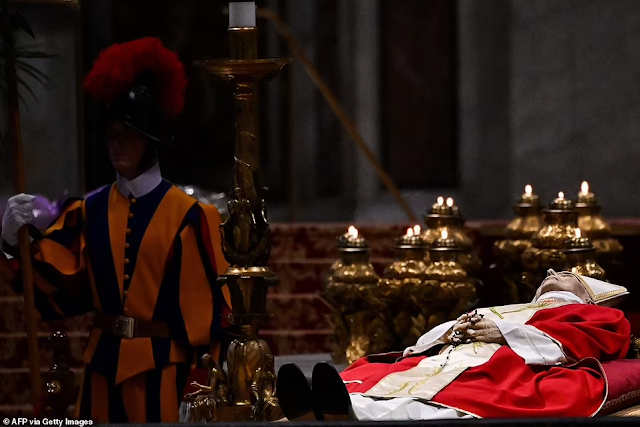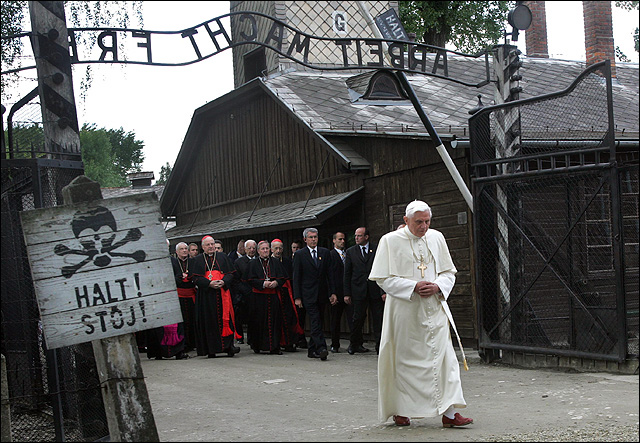Death of Pope Benedict XVI - New Year's Eve 2022 - Reflections on his visit to the Nazi Auschwitz - Birkenau extermination camp in May 2006
Funeral of Benedict XVI
Pope Francis presided over the Requiem Mass of Benedict XVI on Thursday January 5 in St. Peter’s Square.
This ancient rite a was on this occasion a moving ceremony of poised simplicity, as far as magnificent pomp and circumstance can be expressed by the Vatican. Pope Benedict had expressly requested this scaling down of the ceremony. This was the first time in some 600 years that a living Pope and contemporary occupant of the Holy See presided over the funeral of a previous Pope.
I found the homily given by Pope Francis to be a carefully considered strategic approach, given the present voracious and exaggerated appetite of the social and print media for the prurient and sensational in life. He concentrated on the nature of Christian faith and mentioned the 'wisdom, tenderness and devotion' imparted by Pope Benedict XVI only at the conclusion. The success of his ecumenism was clear from the many Christian faiths represented at the funeral.
This peroration neatly avoided any detailed reminder or re-examination of Pope Benedict's not always popular conservatism, his unprecedented resignation (in stark contrast to John Paul II who laboured and suffered through the last horrifying stages of Parkinson's disease until claimed by death) and what many consider to be his inability to properly address sexual crimes and aberrations among Catholic priests and cardinals. This thoughtful, poignant homily also avoided mention of the at times controversial and unexpectedly divisive theological, academic pronouncements and moral conclusions that resulted from his Pole Benedict's pronounced intellectual excursions. He was one of the world's most renowned theologians.
I also found the moments before the coffin was taken into the basilica deeply moving and extraordinarily intimate considering the grandeur and solemnity of the atmosphere and occasion. Pope Francis rose from his wheelchair, clearly with some difficulty, touched the head of the coffin and reverently kissed it as an intimate gesture of affection and religious closure offered to his dear friend, this Roman Catholic religious representative of God on earth.
At St. Peter's this morning, the enduring power of Christian religious faith was demonstrated once again, despite the erosive moral pressures of creeping secularism, abandonment of civilized behavioral standards and the totalitarian brutality of the present.
 |
| Pope Benedict XVI lying in state in St. Peter's Basilica, Rome (Getty Images) |
'Bells tolled and
sirens wailed through the reconstructed streets of the Old Town at the final
moment. It was 2 April 2005. Six days of
official mourning followed. Bank websites were edged in black and everything
was cancelled that smacked of pleasure. Consumption of alcohol and ice-cream
was forbidden. Shrines began to materialize in parks and at war memorials. The infatuation of this society with death
was at its most intense, the
supermarkets piled high with funeral candles. Entire streets were lined
with them enclosed in the characteristic
glass funnels of red, yellow and white – the national colours of Poland
and the Vatican. Knots of people, curiously lacking an air of expectancy, stood
silently behind these flickering rows of
light waiting for a
procession that would
never pass. Entire squares and
window ledges shimmered
in the darkness.
Simply being together in the national family ‘nest’ at this moment
appeared of overriding importance. This
‘Polish Pope’ was symbolically far more
significant to Poles than simply head of the Church of Rome. He was a
conspicuous example of that rare
species, a successful Pole of world power and influence.
Polish eagles
and the national flag, entwined with
that of the Vatican, were draped in
black ribbons. Established wartime
traditions returned to life in this unprepossessing yet most courageous
of capitals. SMS messages were sent in a mysterious and secret communication
network. A directive for the population to meet at this or that place, line with candles this or that street
associated with John Paul II,
extinguish all the city lights at a particular
moment. I obeyed my SMS message
to switch off my home lights at 11.00pm.
His successor
Pope Benedict XVI made a pilgrimage to Poland
in May 2006 following in the footsteps
of his mentor, the man he
assured the assembled hundreds of thousands would very soon be canonized as a saint. Outside the Presidential Palace in Warsaw I found myself among a group
of nuns bobbing about in the breezy
showers like so many raucous gulls. All around
me massive crowds of Poles were willing the German Benedict to be the reincarnation of John
Paul.
At Oświęcim (Auschwitz) a grim, determined German in windswept robes of white and gold walked alone towards the infamous Black Wall where mass executions took place. This reluctant former member of the Hitler Youth was visibly straining to support an intolerable burden of history. In a formidable act of reconciliation, he kissed and caressed a group of survivors who were assembled in an orderly row.
 |
Pope Benedict XVI prays with 32 survivors during a visit to Auschwitz on the last
day of a four-day trip to Poland, May 2006
|
(Photograph: Vincenzo Pinto/AFP/Getty Images) |
At prayers in the extermination camp of Birkenau the rain ceased and a rainbow appeared over the barracks, the crematoria and the symbolic watchtower penetrated by the railway line leading to the loading ramp of death. The spring sun shone full upon him as he sat listening to the singing of the mournful Hebrew lament for the dead. The Middle Ages would have deemed it a miracle.'







Comments
Post a Comment